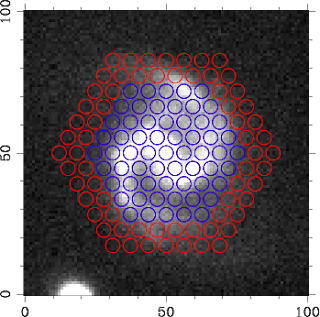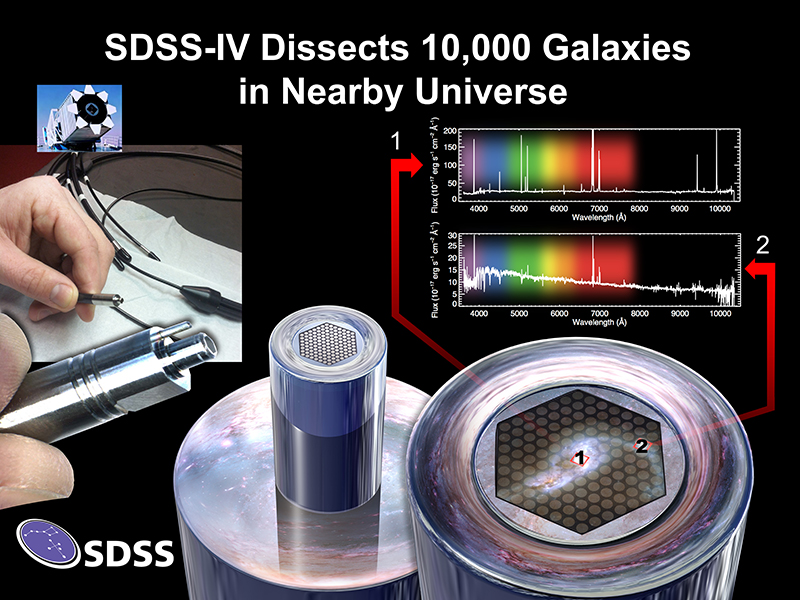Mapping Movement inside nearby galaxies with MaNGA
-
 by
Budgieye
moderator
by
Budgieye
moderator
Mapping Nearby Galaxies...... Ma pping N earby GA laxies
or
The 3-D lives of galaxies
or
Mapping the Inner workings of thousands of nearby galaxies
Do you find ellipticals boring?
Do you know which direction stars are moving in spirals?
Is that tidal trail in the foreground or background?
Does the hydrogen gas in that galaxy move inwards or outwards, or both?
Help will soon arrive!
MaNGA from SDSS will map the movement of stars and gas in galaxies.
How?
Movement of stars and gas moving towards us or away from us can be measured by taking a spectrum and measuring redshift. see Page 3 Spectra Guide for Galaxy Zoo https://talk.galaxyzoo.org/#/boards/BGZ0000001/discussions/DGZ0000ulp?page=3&comment_id=53fef2ee3d5a77490c0001b6
But SDSS has only been taking a sample from the center of a large galaxy. and mabye one or two samples along the arm.
But SDSS MaNGA will take a many samples in a grid pattern.

http://blog.sdss.org/wp-content/uploads/2013/01/manga_galaxy_illustration.pngSo the redshift and blueshift of stars and gas of all areas of the galaxy can be measured.
 http://blog.sdss3.org/2013/01/23/demonstrating-the-manga-instrument-at-apo/
http://blog.sdss3.org/2013/01/23/demonstrating-the-manga-instrument-at-apo/SDSS Mapping Nearby Galaxies at APO (MaNGA) http://www.sdss.org/surveys/manga/ "Unlike previous SDSS surveys which measured spectra only at the centers of target galaxies, MaNGA bundles sets of optical fibers into tightly-packed arrays, enabling spectral measurements across the face of each of ~10,000 nearby galaxies. MaNGA’s goal is to understand the “life cycle” of present day galaxies from imprinted clues of their birth and assembly, through their ongoing growth via star formation and merging, to their death from quenching at late times."
Not to be confused with the Japanese cartoon with a similar name 😃
phrase to learn Integral field spectroscopy (IFS)

SDSS website: MaNGA Mapping Nearby Galaxies at APO 2013 http://www.sdss.org/surveys/manga/
SDSS webstie: MaNGA’s First Galaxies MAY 6, 2014 by Anne-Marie Weijmans, the MaNGA Lead Observer: http://blog.sdss3.org/2014/05/06/mangas-first-galaxies/ scheduled to start observing in July 2016, but several galaxies have been done already "MaNGA is an integral-field spectroscopy survey, which will map the motions and properties of stars and gas in 10,000 galaxies. By grouping fibers together into integral-field units, MaNGA obtains spectra not just of the centre of the galaxy, but also its outskirts, covering the whole galaxy. This means that we can measure properties of stars, such as age and metallicity, over a large surface area in the galaxy, and based on that, figure out how these galaxies were assembled. We also are able to measure the velocities of the stars, which in turn tells us about the structure of the galaxy, and how much dark matter is present. From the gas, we learn about the radiation present in the galaxy: is the gas energized by young stars (indicating that there is on-going star formation), by an active black hole, or both? Combining all these different sets of information, we form a picture of how different galaxies form, and evolve over time."
Demonstrating the MaNGA Instrument at APO
JANUARY 23, 2013 / BSOUTERhttps://twitter.com/mangasurvey
SDSS website: MaNGA (overview) http://www.sdss3.org/future/manga.php
http://blog.sdss.org/2016/01/05/astronomers-studying-galaxy-mergers-using-manga-data/
OVERVIEW OF THE SDSS-IV MaNGA SURVEY: MAPPING NEARBY GALAXIES AT APACHE POINT OBSERVATORY
Kevin Bundy et al http://iopscience.iop.org/article/10.1088/0004-637X/798/1/7/meta;jsessionid=BF9BDCAE2CEC37461BF032CB8C625CB4.c4.iopscience.cld.iop.orgTHE MANGA INTEGRAL FIELD UNIT FIBER FEED SYSTEM FOR THE SLOAN 2.5 M TELESCOPE
N. Drory1 et al http://iopscience.iop.org/article/10.1088/0004-6256/149/2/77/metaP-MaNGA Galaxies: emission-lines properties – gas ionization and chemical abundances from prototype observation (Abstract) http://mnras.oxfordjournals.org/content/449/1/867
P-MaNGA: full spectral fitting and stellar population maps from prototype observations (Abstract) http://mnras.oxfordjournals.org/content/449/1/328
P-MaNGA: Gradients in Recent Star Formation Histories as Diagnostics for Galaxy Growth and Death, Li et al., 2015, arXiv:1502.07040. http://adsabs.harvard.edu/abs/2015arXiv150207040L
Galaxy Zoo: 3D https://www.zooniverse.org/projects/klmasters/galaxy-zoo-3d
We need your help to classify the internal structures of galaxies which are being observed by the MaNGA survey.
MaNGA ("Mapping Nearby Galaxies at Apache Point Observatory") is in the process of measuring hundreds of spectra (very detailed rainbows) from each of almost ten thousand nearby galaxies. With your help we can better understand what structures in the galaxies the spectra come from. The picture below shows a typical MaNGA target galaxy with the hexagonal bundle overlaid. A spectra is measured in each small circle, so you can see how they pick up the light from different features in the galaxy.Talk: MANGA targeting? by mlpeck https://talk.galaxyzoo.org/#/boards/BGZ0000007/discussions/DGZ0001z7q
Zooite mlpeck is trying his own 3D mapping of galaxy rotation, using published data. There are useful hints and refererences.SDSS-IV MaNGA: faint quenched galaxies I- sample selection and evidence for environmental quenching https://research-repository.st-andrews.ac.uk/bitstream/handle/10023/9354/Weijmans_2016_MNRAS_MaNGA_AM.pdf?sequence=1&isAllowed=y
The Masters et al. "passive red spirals" in MaNGA 1st data release mlpeck
https://talk.galaxyzoo.org/#/boards/BGZ0000007/discussions/DGZ00024dcPosted
-
 by
Budgieye
moderator
by
Budgieye
moderator
First MaNGA image of a lenticular galaxy http://www.sdss.org/surveys/manga/

Example MaNGA maps from the Jan 2013 test run. Credit: Sebastian Sanchez.
My attempt at interpretation:
Gas intensity: ummm,,, there is more hydrogen gas near the center of the galaxy? Measured by height of hydrogen alpha peak?
Gas Velocity: The hydrogen gas is spinning around one axis, blue gas coming towards us, red gas going away. Fastest gas near the dust lanes ie along the plane of the galaxy. Measured by redshift and blueshift of hydrogen alpha EDITED absorption.
Stellar age: ummm, the oldest stars are represented by red and are on the left and the right? Measured by the amount of red light, which is from red stars, which are the oldest stars.
Stellar velocity: The stars are spinning around one axis, blue coming towards us, red going away. Measured by ...
This is a simple example. I have a feeling that they will get more complicated.
This is apparently a lenticular with dust lane?
http://skyserver.sdss.org/dr12/en/tools/explore/Summary.aspx?id=1237667293191667802
Posted
-
This is so exciting! Finally a truly 'proper' way of measuring redshifts 😃 !
Gut feeling that MaNGA will yield really unexpected and spectacular results.
Stellar velocity probably measured by comparing redshifts of receding side, approaching side and center.
Thanks for posting!
Posted
-
 by
klmasters
scientist, admin
by
klmasters
scientist, admin
It's a great survey to be involved in, and I have some plans to ask for some help from you guys also. I'd like to be able to tag what internal structure each spectrum comes from, so working on a project to make on the images of galaxies exactly where the spiral arms are. Turns out this is quite challenging!
We'll also want help visually classifying the rotation maps at some point. We're going to try that out this summer on a small sample with some of the scientists and see how it goes (can't make them public yet unfortunately - but that will happen).
We do have MaNGA data for one of the Galaxy Zoo: Mergers sample (the yin-yang, or heart galaxy) which is very interesting. We can test how well the models reproduced the velocities. 😃
You can measure the redshift/blueshift of stars using absorption line features in their spectra, so that's how we get separate stellar motions and gas motions (from the Halpha and other emission line redshift/blueshift).
I'll try to find some time for a longer post about MaNGA soon. It's something I've been working a lot on in the last couple of years, so I should be telling you about it.
So many galaxies, so little time! 😃
Posted
-
 by
Budgieye
moderator
by
Budgieye
moderator
Thank you Dr Masters. We are looking forward to seeing more preliminary results, and the papers. It will be challenging to help.
I have corrected the error in gas movement (absorption lines, not emission lines!) in my previous post.
Posted
-
 by
ElisabethB
moderator
by
ElisabethB
moderator
Sounds exciting ! 😄
Posted
-
 by
JeanTate
in response to klmasters's comment.
by
JeanTate
in response to klmasters's comment.
Very cool! 😃
Can't wait to start classifying MaNGA images/data!!
Posted
-
 by
zutopian
in response to klmasters's comment.
by
zutopian
in response to klmasters's comment.
I'll try to find some time for a longer post about MaNGA soon. It's something I've been working a lot on in the last couple of years, so I should be telling you about it.
Please be informed, that there is a related #manga GZ Talk discussion.:
MANGA targeting?
https://talk.galaxyzoo.org/#/boards/BGZ0000007/discussions/DGZ0001z7qPS: Could someone please contact klmasters? I replied to a post, which she had done two months ago!
Posted
-
 by
zutopian
by
zutopian
Another related GZ Talk topic:
The Masters et al. "passive red spirals" in MaNGA 1st data release
Started September 10 2016 10:48 AM by mlpeck
https://talk.galaxyzoo.org/#/boards/BGZ0000007/discussions/DGZ00024dcPosted
-
 by
Budgieye
moderator
by
Budgieye
moderator
SDSS dr13 has a MaNGA file, in FITS and it is 158 MB
http://skyserver.sdss.org/dr13/en/tools/explore/summary.aspx
Posted
-
 by
klmasters
scientist, admin
by
klmasters
scientist, admin
SDSS DR14 will have more accessible versions of the MaNGA data. Planned for end of July 2017. In this first release we only made public the "spectral cubes" (think of them as thousands of images at different wavelengths, or hundreds of spectra of of each galaxy). The next one will include files with maps made out of these, including motions of stars, gas, important emission line images etc.
Posted
-
 by
klmasters
scientist, admin
by
klmasters
scientist, admin
You can explore the images of the MaNGA galaxies in this new Zooniverse project we just put into beta test today. I started a thread here to collect your views on it: https://talk.galaxyzoo.org/#/boards/BGZ0000001/discussions/DGZ00025q2
Posted
-
 by
OMKADAM
by
OMKADAM
galaxy starbursts
Posted